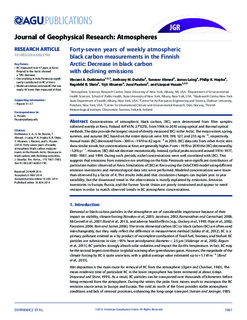Forty-seven years of weekly atmospheric black carbon measurements in the Finnish Arctic: Decrease in black carbon with declining emissions
| dc.contributor.author | Dutkiewicz, V. A. | |
| dc.contributor.author | DeJulio, A. M. | |
| dc.contributor.author | Ahmed, T | |
| dc.contributor.author | Laing, J | |
| dc.contributor.author | Hopke, P. K. | |
| dc.contributor.author | Skeie, Ragnhild Bieltvedt | |
| dc.contributor.author | Viisanen, Y | |
| dc.contributor.author | Paatero, J. | |
| dc.contributor.author | Husain, Liaquat | |
| dc.date.accessioned | 2017-11-09T12:42:49Z | |
| dc.date.available | 2017-11-09T12:42:49Z | |
| dc.date.created | 2014-08-19T12:41:35Z | |
| dc.date.issued | 2014 | |
| dc.identifier.citation | Journal of Geophysical Research - Atmospheres. 2014, 119 (12), 7667-7683. | |
| dc.identifier.issn | 2169-897X | |
| dc.identifier.uri | http://hdl.handle.net/11250/2465253 | |
| dc.description | © 2014 American Geophysical Union. All Rights Reserved | |
| dc.description.abstract | Concentrations of atmospheric black carbon, [BC], were determined from filter samples collected weekly at Kevo, Finland (69°45′N, 27°02′E), from 1964 to 2010 using optical and thermal optical methods. The data provide the longest record of directly measured [BC] in the Arctic. The mean winter, spring, summer, and autumn [BC] based on the entire data set were 339, 199, 127, and 213 ng m−3, respectively. Annual mean [BC] decreased from ~300 in ~1970 to 82 ng m−3 in 2010. [BC] data sets from other Arctic sites show similar trends, but concentrations at Kevo are generally higher. From ~1970 to 2010 the [BC] decreased by ~1.8% yr−1. However, [BC] did not decrease monotonically. Instead, cyclical peaks occurred around 1976–1977, 1985–1987, and 1999. During such periods, nickel concentrations were well correlated with [BC]. This suggests that emissions from extensive ore smelting on the Kola Peninsula were significant contributors of particulate matter observed at Kevo. Simulations of [BC] at Kevo using the OsloCTM3 model using different emission inventories and meteorological data sets were performed. Modeled concentrations were lower than observed by a factor of 4. The results indicated that circulation changes can explain year to year variability, but the downward trend in the observations is mostly explained by emissions. Emission inventories in Europe, Russia, and the former Soviet Union are poorly constrained and appear to need revision in order to match observed trends in BC atmospheric concentrations. | |
| dc.language.iso | eng | |
| dc.title | Forty-seven years of weekly atmospheric black carbon measurements in the Finnish Arctic: Decrease in black carbon with declining emissions | |
| dc.type | Peer reviewed | |
| dc.type | Journal article | |
| dc.description.version | publishedVersion | |
| dc.source.pagenumber | 7667-7683 | |
| dc.source.volume | 119 | |
| dc.source.journal | Journal of Geophysical Research - Atmospheres | |
| dc.source.issue | 12 | |
| dc.identifier.doi | 10.1002/2014JD021790 | |
| dc.identifier.cristin | 1147799 | |
| dc.relation.project | Norges forskningsråd: 208277 | |
| cristin.unitcode | 7475,0,0,0 | |
| cristin.unitname | CICERO Senter for klimaforskning | |
| cristin.ispublished | true | |
| cristin.fulltext | original | |
| cristin.fulltext | ||
| cristin.qualitycode | 2 |
Tilhørende fil(er)
Denne innførselen finnes i følgende samling(er)
-
Journal articles [468]
